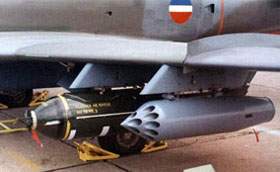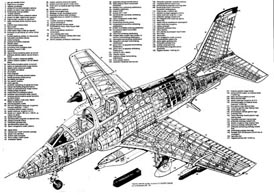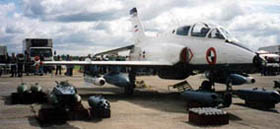|
Manufacturer: |
Vazduhoplovna
Industrija SOKO DD |
Country of
origin: |
Yugoslavia |
Class: |
Trainer |
Type: |
Basic/advanced flying
and armament trainer with light attack capability |
Powerplant: |
One DMB
(Rolls-Royce/Bristol Siddeley) Viper Mk 632-46 turbojet rated at 17.79 kN dry |
Fuel capacity: Internal
fuel 1307 kg; external fuel up to 575 kg in two 369 liter drop tanks; no provision for
in-flight refueling |
Dimensions: |
Wing: Span 9.88 m;
aspect ratio 5.01; area 19.50 m2 |
Fuselage and tail
dimensions: Length 12.25 m including probe and 11.35 m excluding probe; height 4.30 m;
tailplane span 3.97 m; wheel track 3,50 m; wheel base 4.15 m Operational weights: Empty
3250 kg equipped; normal take-off 4760 kg for a training mission or 6110 kg on a normal
attack mission with a warload of 1350 kg; maximum take-off weight 6330 kg |
Performance: |
Never exceed speed 921
km/h at 11000 m; maximum level speed ‘clean’ 920 km/h at 6000 m and 910 km/h at 4000
m; cruising speed, maximum 845 km/h at 6000 m and economical 550 km/h at 6000 m |
Ferry range 2500 km
with drop tanks; range 1900 km with standard fuel or 1300 km with cannon pack and four
BL755 cluster bombs; radius 390 km on a lo-lo-lo attack mission with cannon pack and four
BL755 cluster bombs, or 485 km on a hi-lo-hi attack mission with cannon pack and four
BL755 cluster bombs, or 595 km on a lo-lo-lo attack mission with two BL755 cluster bombs
and two drop tanks, or 810 km on a hi-lo-hi attack mission with two BL755 cluster bombs
and two drop tanks |
Maximum rate of climb
at sea level 1860 m per minute; climb to 8000 m in 6 minutes; service ceiling 12850 m |
G limits: -4.2 to +8 |
Crew: |
Pupil and instructor in
tandem on Martin-Baker Mk 10Y zero/zero ejector seats |
 |
Fixed armaments:
One 23 mm Gryazev-Shipunov GSh-23L two barrel
cannon with 200 rounds in a optional 750 kg ventral pack
Disposable armaments:
Up to
1280 kg of disposable stores carried on four hardpoints (all under the wings with the
inner two units each rated at 360 kg and the outer two units each at 250 kg); typical
weapons are triplets of 100 and 50 kg bombs, S-8-16 cluster bomb with eight 16 kg
fragmentation bomblets, KPT-150 dispenser with 40 anti-personnel or 54 anti-tank minelets,
napalm tanks, L-57-16MD multiple launcher carrying 55 mm unguided rockets, L-128-04
multiple launcher carrying four 128 mm unguided rockets, twin launcher for 128 mm HVAR
unguided rockets, and KM-3 pod with one 12,7 mm heavy machine gun |
|
Electronics
& operational equipment: |
Standard communication
and navigation equipment, plus (fire control and weapons management) Ferranti ISIS D-282
gyro sight, and (defensive sensors and systems) Iskra SD-1 RWR; there is also provision
for a reconnaissance pod with cameras and an IR linescaner |

|
| Operators: |
| Burma (12) |
| SFR Yugoslavia (75+) |
Variants: |
G-4 Super Galeb:
Designed to replace the G-2 Galeb and Lockheed T-33 in Yugoslav service, the Super Galeb
(super seagull) bears no more relationship to the G-2 Galeb than an identity of role,
being and altogether more advanced machine with marked conceptual similarities to the BAe
Hawk. The type was first flown in July 1978 as the G-4PPP prototype, which, with the
following six pre- production aircraft, had a straight tailplane with conventional inset
elevators. However, the G-4 production variant that entered in service in 1983 has a slab
tailplane of distinct anhedral. The type offers a modest light attack facility in addition
to the standard training role, and this capability is being expanded under an improvement
program revealed in 1990 but interrupted by civil war as the former Yugoslavia fragments
into a number of smaller states. The improvement program is designed to upgrade engine
performance under icing conditions, update the electrical and electronic (including
nav/attack) systems, and enhance weapon capability for missiles such as the R-60 (AA-8
“Aphid”) and R-73 (AA-11 “Archer”) short range AAMs, and Kh-23 (AS-7 “Kerry”)
and AS-9 “Kyle” ASMs. |
 |
G-4M
Super Galeb: Thought it is an abeyance because of the civil war attendant on the
dissolution of Yugoslavia as a real entity, the program for this upgraded Super Galeb mat
been revived to provide a more capable type in the armament training and light attack
roles. The variant’s improvements stem from the use of more advanced avionics and
higher-rated hardpoints complemented by a missile rail at each wing tip. The avionics
include a Zrak ENP-MG4 HUD, Rudi Cajavec ENS-MG4 electronic sight, gyro platform, multi
function displays, and optional chaff/flare dispensers. The inner and outer hardpoints are
each rated at 500 and 350 kg respectively for a maximum disposable load of 1800 kg. In
other respect, the G-4M differs from the G-4 in details such as span of 10.05 m excluding
tip-mounted AAMs or 10.31 m including tip-mounted AAMs, aspect ratio of 5.18, empty
equipped weight of 3403 kg without missile rails and 3435 kg with missile rails, internal
fuel weight of 1376 kg supplemental by up to 925 kg of external fuel in one 449 liter and
two 368 liter drop tanks, normal take-off weight of 4971 kg as a trainer, maximum take-off
weight of 6400 kg as an attack warplane, maximum level speed ‘clean’ of 865 km/h at
10000 m and 900 km/h at 4000 m, ferry range of 2900 km with drop tanks; range of 1800 km
with standard fuel reducing to 1200 km with cannon pack, four BL755 cluster bombs and two
AAMs, maximum rate of climb at sea level of 1800 m per minute, and service ceiling of
12500 m.
special thanks to
Luka Baturan |
|
|

